Dionne quintuplets
The Dionne quintuplets (French pronunciation: [djɔn]; born May 28, 1934) are the first quintuplets known to have survived their infancy. The identical girls were born just outside Callander, Ontario, near the village of Corbeil. All five survived to adulthood.[1]
Dionne quintuplets | |
|---|---|
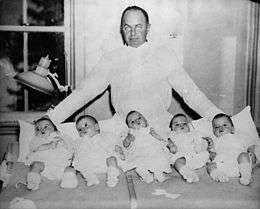 Ontario Premier Mitchell Hepburn with the Dionne babies in 1934 | |
| Born | May 28, 1934 Callander, Ontario, Canada |
| Died | Annette and Cécile are alive Yvonne: June 23, 2001 (aged 67) Montreal, Quebec Émilie: August 6, 1954 (aged 20) Sainte-Agathe-des-Monts, Quebec Marie: February 27, 1970 (aged 35) Montreal, Quebec |
| Known for | Being identical quintuplets |
| Parent(s) |
|
The Dionne girls were born two months premature. After four months with their family, custody was signed over to the Red Cross who paid for their care and oversaw the building of a hospital for the sisters. Less than a year after this agreement was signed, the Ontario Government stepped in and passed the Dionne Quintuplets' Guardianship Act, 1935 which made them Wards of the Crown until the age of 18.[2] The Ontario provincial government and those around them began to profit by making them a significant tourist attraction.
The identical quintuplet girls were, in order of birth:
- Yvonne Édouilda Marie Dionne (died 2001)
- Annette Lillianne Marie Allard (living)
- Cécile Marie Émilda Langlois (living)
- Émilie Marie Jeanne Dionne (died 1954)
- Marie Reine Alma Houle (died 1970)
Biography
Family
The Dionne family was headed by father Oliva-Édouard (1904–1979) and mother Elzire Dionne (née Legros; 1909–1986), who married on September 15, 1925. They lived just outside Corbeil, in a farmhouse in unregistered territory. Oliva, through his father, was a descendant of Zacharie Cloutier[3] (via Louise Cloutier, 1632–1699; Charlotte Mignault, 1669–1747; and Antoine Dionne, 1707-1779). The Dionnes were a French-speaking farming family with five older children, Ernest (1926–1995), Rose Marie (1928–1995), Thérèse (b. 1929), Daniel (1932–1995), and Pauline (b. 1933), who was only eleven months older than the quintuplets. A sixth child, Léo (b. 1930), died of pneumonia shortly after birth.
The Dionnes also had three sons after the quintuplets: Oliva Jr. (1936–2017), Victor (1938–2007), and Claude (1946–2009).
Birth
Elzire suspected she was carrying twins, but no one was aware that quintuplets were even possible. The quintuplets were born two months premature. In 1938, the doctors had a theory that was later proven correct when genetic tests showed that the girls were identical, meaning they were created from a single egg cell. Elzire reported having had cramps in her third month and passing a strange object which may have been a sixth fetus.[4]
Dr. Allan Roy Dafoe is credited with ensuring the successful live birth of the quintuplets. Originally, he diagnosed Elzire with a "fetal abnormality". He delivered the babies with the help of two midwives, Aunt Donalda and Madame Benoît Lebel, who were summoned by Oliva Dionne in the middle of the night.[4]
Émilie and Marie shared an embryonic sac, Annette and Yvonne shared an embryonic sac, and it is believed that Cécile shared an embryonic sac with the miscarried sixth baby.[5] All but Émilie were later discovered to be right-handed[6] and all but Marie had a counterclockwise whorl in their hair.[7][8]
The quintuplets' total weight at birth was 13 pounds, 6 ounces (6.07 kg). Their individual weights and measurements were not recorded. The quintuplets were immediately wrapped in cotton sheets and old napkins, and laid in the corner of the bed. Elzire went into shock, but she recovered in two hours.[4][8]
The babies were kept in a wicker basket borrowed from the neighbours, covered with heated blankets. They were brought into the kitchen and set by the open door of the stove to keep warm. One by one, they were taken out of the basket and massaged with olive oil. Every two hours for the first twenty-four, they were fed water sweetened with corn syrup. By the second day they were moved to a slightly larger laundry basket and kept warm with hot-water bottles. They were watched constantly and often had to be roused. They were then fed with "seven-twenty" formula: cow's milk, boiled water, two spoonfuls of corn syrup, and one or two drops of rum for a stimulant.[9]
News of the unusual birth spread quickly, sparked by Oliva's brother's inquiry to the local newspaper editor about how much he would charge for an announcement of five babies at a single birth. Before long, people from all over North America were offering assistance. Individuals sent supplies and well-meant advice (a famous letter from Appalachia recommends tiny doses of burnt rye whiskey to prevent diarrhoea);[10] one hospital sent two incubators.
Taken from parents
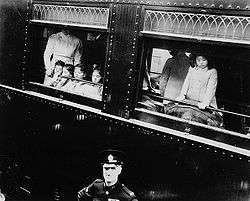
Oliva Dionne was approached by fair exhibitors for Chicago's Century of Progress exhibition within days of the girls' birth, seeking to put the quintuplets on display and show them to the world. (At the time it was not unusual for so-called "incubator babies" to be displayed at fairs and other exhibitions.[11]) The parents were persuaded to agree on the advice of the doctor present at the birth, Dr. Dafoe, and the family priest, Father Daniel Routhier.
Although Oliva Dionne revoked the contract only days later citing that his wife, Elzire Dionne, did not sign it and therefore it didn't make the contract valid, the Tour Bureau claimed otherwise. On approximately July 27, 1934 the first guardianship bill was signed. Oliva and Elzire Dionne signed custody of the quintuplets over to the Red Cross for a period of two years to protect them from this contract and in return the Red Cross would cover all medical costs. This included the nurses' wages, supplies, and ensuring that enough breast milk was being shipped to the hospital. They also oversaw the building of a hospital built specifically for the Dionne quintuplets. In February of 1935 the Dionnes travelled to Chicago as "Parents of the World Famous Babies" and made stage appearances. The Premier of Ontario at the time, Mitchell Hepburn, used the Dionne vaudeville trip as an excuse to extend the guardianship. He claimed that they must save the babies from further exploitation and, in March 1935, pushed the Dionne Quintuplets Act through government that officially made the girls Wards of the Crown and extended guardianship to the age of eighteen. Although Oliva Dionne had a seat on the Board of Guardians, he rarely attended meetings as he felt his vote wouldn't matter against the other three guardians: Dr. Dafoe, Joseph Valin and Minister of Welfare David Croll. The stated reason for removing the quintuplets from their parents' legal custody was to ensure their survival and protection from promoters.
The government realized there was enormous public interest in the sisters and proceeded to engender a tourist industry around them.[12] The girls were made wards of the provincial Crown, planned until they reached the age of 18.[13]
At the Dafoe Nursery
Across the road from their birthplace, the Dafoe Hospital and Nursery was built for the five girls and their new caregivers. The girls were moved from the farmhouse to this nursery on September 21, 1934 and lived there until they were nine years old.[12] The compound had an outdoor playground designed to be a public observation area. It was surrounded by a covered arcade, which allowed tourists to observe the sisters behind one-way screens. The facility was funded by a Red Cross fundraiser. The sisters were brought to the playground two or three times a day in front of the crowd.[12][13] It was a nine-room nursery with a staff house nearby. The staff house held the three nurses and the three police in charge of guarding them, while a housekeeper and two maids lived in the main building with the quintuplets. The buildings were surrounded by a seven-foot (2.13 m) barbed-wire fence.
The Dionne sisters were constantly tested, studied, and examined, with records being taken of everything. While living at the compound, they had a somewhat rigid lifestyle. They were not required to participate in chores and were privately tutored in the same building where they lived. Cared for primarily by nurses, they had limited exposure to the world outside the boundaries of the compound except for the daily rounds of tourists, who, from the sisters' point of view, were generally heard but not seen.[12] They also had occasional contact with their parents and siblings across the road. Every morning they dressed together in a big bathroom, had doses of orange juice and cod-liver oil, and then went to have their hair curled. They then said a prayer, a gong was sounded, and they ate breakfast in the dining room. After thirty minutes, they had to clear the table. They then went and played in the sunroom for thirty minutes, took a fifteen-minute break, and at nine o'clock had their morning inspection with Dr. Dafoe. Every month they had a different timetable of activities. They bathed every day before dinner and put on their pyjamas. Dinner was served at precisely six o'clock. They then went into the quiet playroom to say their evening prayers. Each girl had a colour and a symbol to mark whatever belonged to her. Annette's colour was red and her design a maple leaf, Cécile's green and a turkey. Émilie had white and a tulip, Marie blue and a teddy bear, and Yvonne pink and a bluebird.[14]
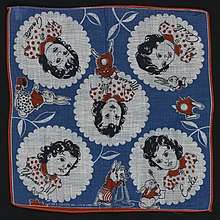
Approximately 3,000 people per day visited the observation gallery that surrounded the outdoor playground to view the Dionne sisters. Ample parking was provided and almost 3,000,000 people walked through the gallery between 1936 and 1943. Oliva Dionne ran a souvenir shop and a woolen store opposite the nursery and the area acquired the name "Quintland". The souvenirs, picturing the five sisters, included autographs and framed photographs, spoons, cups, plates, plaques, candy bars, books, postcards, and dolls. Available to the public for free in bins were stones from the area that claimed to have the magical power of fertility – the bins would need to be refilled almost every day. Midwives Madame LeGros and Madame Lebel worked at five different souvenir shops at different times. [15] The quintuplets brought in more than $50 million in total tourist revenue to Ontario.[16] Quintland became Ontario's biggest tourist attraction of the era, surpassing the Canadian side of Niagara Falls.[13] It was only rivalled by Radio City Music Hall, Mount Vernon, and Gettysburg in the United States. Hollywood stars who came to Callander to visit the Quints included Clark Gable, James Stewart, Bette Davis, James Cagney, and Mae West. Amelia Earhart also visited Callander just six weeks before her ill-fated flight in 1937.[17]
The sisters, their likenesses and images, along with Dr. Dafoe, were used to publicize commercial products including Karo corn syrup and Quaker Oats. They promoted the sales of condensed milk, toothpaste, disinfectant, and many other products.[13]
Film career
The Dionne girls starred in three Hollywood feature films, which were essentially fictionalised versions of their story. They played the 'Wyatt Quintuplets' in all three films:
- The Country Doctor (1936) – directed by Henry King and starring Jean Hersholt
- Five of a Kind (1938) - The sequel to the above film.
- Reunion (1936)[18]
In the first two films, the Dionne quintuplets didn't so much act as simply appear. Their scenes were filmed at Quintland in Callander, and largely consisted of them playing and interacting with each other, as one would expect of normal 2- and 4-year-old children. Both films concentrated more on telling the (fictionalized) story of the heroic doctor who delivered the Wyatts and took care of them, than it did on the Wyatt quintuplets themselves.
The Dionne quintuplets also appeared in numerous newsreels and a short documentary film called Five Times Five in 1939. This film was nominated for an Oscar in 1940.[19] In 1942, they appeared in one of James A. Fitzpatrick's Traveltalks Land of the Quintuplets shortly before they were returned to their parents. In 1998, the three surviving sisters, Cécile, Annette and Yvonne, participated in an hour-long documentary, "Full Circle: The Untold Story of the Dionne Quintuplets", written and directed by Maya Gallus, and broadcast on the CBC documentary series Life & Times.
Return to family
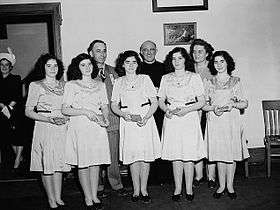
By 1939 Dr. Dafoe had resigned as guardian and Oliva Dionne was gaining more support to have his family reunited. In 1942, the Dionne family moved into the Nursery with the Quintuplets while they waited for their new home to be completed. In November 1943, the entire Dionne family moved into their new home. The yellow brick, 20-room mansion was paid for out of the quintuplets' fund. The home had many amenities that were considered luxuries at the time, including telephones, electricity and hot water and was nicknamed "The Big House". The building is now a retirement home.[20]
The nursery was eventually converted into an accredited school house where the sisters finished their secondary education along with ten girls from the area who were chosen to attend. In later years, it was used by the Recluses of Corbeil as a convent.
While the parents claimed that they wished to integrate the quintuplets into the family, the sisters frequently travelled to perform at various functions, and still dressed identically. According to the accounts of the surviving sisters, the parents often treated them at home as a five-part unit, and frequently lectured them about the trouble they had caused the family by existing. They were sometimes denied privileges the other children received, and were more strictly disciplined and punished. They also received a heavier share of the housework and farmwork. They were unaware for many years that the lavish house, the expensive food and the series of cars the family enjoyed were paid for with money they themselves had earned.
In particular, Oliva Dionne was resentful and suspicious of outsiders as a result of his having lost custody of the girls. In 1995, the three surviving sisters alleged that their father had sexually abused them during their teenaged years.[21]
Adult years
The quintuplets left the family home upon turning 18 years old in 1952 and had little contact with their parents afterwards. Three went on to marry and have children: Marie had two daughters, Annette three sons, and Cécile five children, including one who died in infancy and twins Bruno and Bertrand.[22] Émilie devoted her brief life to becoming a nun. Yvonne finished nursing school before turning to sculpting, then later becoming a librarian.[23] Émilie died at the age of 20 as a result of a seizure. She had a series of seizures while she was a postulant at a convent and had asked not to be left unattended, but the nun who was supposed to be watching her thought she was asleep and went to Mass. Émilie had another seizure, rolled onto her belly and, unable to raise her face from her pillow, accidentally suffocated.[24] In 1970, Marie was living alone in an apartment and her sisters were worried after not hearing from her in several days. Her doctor went to her home and found her in bed, Marie having been dead for days. Her estranged husband quickly reported to the media that there had been a blood clot in her brain.
Annette and Cécile both eventually divorced and by the 1990s, the three surviving sisters lived together in the Montreal suburb of Saint-Bruno-de-Montarville.
In 1965, author James Brough wrote a book, in cooperation with the then four surviving sisters, called We Were Five. Pierre Berton published a biography called The Dionne Years: A Thirties Melodrama in 1977 and narrated a 1978 National Film Board of Canada documentary. John Nihmey and Stuart Foxman published the fictional Time of Their Lives — The Dionne Tragedy in 1986. Nihmey's and Foxman's book was the basis for the 1994 TV miniseries Million Dollar Babies, produced by CBC and CBS and starring Beau Bridges, Roy Dupuis and Céline Bonnier.
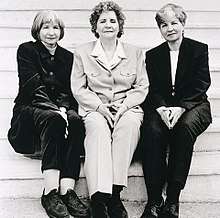
In 1997, the three surviving sisters wrote an open letter to the parents of the McCaughey septuplets, warning against allowing too much publicity for the children. The letter read:[25][26]
Dear Bobbi and Kenny,
If we emerge momentarily from the privacy we have sought all our adult lives, it is only to send a message to the McCaughey family. We three would like you to know we feel a natural affinity and tenderness for your children. We hope your children receive more respect than we did. Their fate should be no different from that of other children. Multiple births should not be confused with entertainment, nor should they be an opportunity to sell products.
Our lives have been ruined by the exploitation we suffered at the hands of the government of Ontario, our place of birth. We were displayed as a curiosity three times a day for millions of tourists. To this day we receive letters from all over the world. To all those who have expressed their support in light of the abuse we have endured, we say thank you. And to those who would seek to exploit the growing fame of these children, we say beware.
We sincerely hope a lesson will be learned from examining how our lives were forever altered by our childhood experience. If this letter changes the course of events for these newborns, then perhaps our lives will have served a higher purpose.
Sincerely, Annette, Cécile and Yvonne Dionne
In 1998, the sisters reached a $2.8 million settlement with the Ontario government as compensation for their exploitation.[27][28]
As of December 2019 there are two surviving sisters, Annette and Cécile. Yvonne died in 2001.[29]
Dionne Quints Museum
A sibling of the quintuplets was the first to open the Dionne home as a museum. The original family homestead was moved around 1960 to a location on Highway 11B (near the present Clarion Resort), and again in 1985 to North Bay and converted into the non-profit Dionne Quintuplets Museum. The museum was first located at the intersection of Highway 11 and the Trans Canada Highway and features many artifacts from the quints' early days and their growing years. As of October, 2016, the museum closed, and the city of North Bay was considering selling the building as surplus, though a petition was circulated by citizens to have it designated and preserved as a historical structure. In 2017, plans surfaced for the city to sell the building, and relocate it to a fairground in the village of Sundridge 75 km south of North Bay.[12] On November 9, 2017 the City of North Bay announced plans to move the house on November 19 to a new site in downtown North Bay (on Oak Street in a vacant area between Marina Point Retirement Residence and Discovery North Bay Museum, a former CPR Station c. 1903) and reopened in spring 2019.[30]
Callander Bay Heritage Museum and Alex Dufresne Gallery
On July 21, 1981 the Callander Bay Heritage Museum located at 107 Lansdowne St. E. in Callander opened to the public. The museum, located in the prior home and practice of Dr. Dafoe, tells the story of the Dionne quintuplets, Dr. Dafoe, and other history of the area such as the logging industry, history of shipping on Lake Nipissing, geology and more. Of special note is a barber shop exhibit. The shop first operated on Main Street in Callander (across from the current Foodland) until approximately 1979 when the Township purchased the Dafoe homestead and turned it into a museum. The town barber, Alex Dufresne, was a driving force behind creating a community museum and he donated his barber shop for installation in the museum. The sinks, chairs, mirror and other pieces are all original. When an art gallery was added in 1994 it was fitting to call it the Alex Dufresne Gallery in honor of the museum's found and first chair. Five minutes down the road from the museum is the original "Quintland" site. Yvonne, Annette, Cecile and some of their children visited the museum in 1986. In the 1930s and 1940s, celebrities such as Amelia Earhart, Jimmy Stewart, Bette Davis, James Cagney and Dennis Morgan all visited Dr. Dafoe at his home. In 2016, Brooke Shields and Beau Bridges visited the museum when they were in the area filming a movie. Bridges had played Dr. Dafoe in the tv-movie Million Dollar Babies and Shields' interest in the quintuplets stemmed from her mother's interest in them.
In popular culture
Raymond Chandler described "an advertising calendar showing the Quints rolling around on a sky-blue floor, in pink dresses, with seal-brown hair and sharp black eyes as large as mammoth prunes" in chapter 11 of his 1939 novel "The Big Sleep".[31]
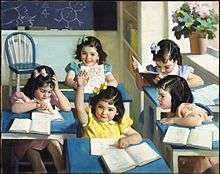
Canadian mystery writer Louise Penny said the fictional Ouellet quintuplets in her book How The Light Gets In "were certainly inspired by the Dionne girls".[32]
In the 1935 film A Night at the Opera, Chico makes an oblique reference to the quintuplets, when he says that 'duplicates' are 'those five kids up in Canada'.
In the 1935 film, Man of the Moment, Tony, played by Douglas Fairbanks Jr., says, "No, my name is Dionne. I'm the second of the quintuplets."[33]
In the 1936 film My Man Godfrey, Angelica Bullock, played by Alice Brady, references the Dionne Quintuplets with the line, "If a woman in Canada can have five children, why can't Godfrey?"
In the 1937 British comedy film Oh, Mr Porter!, Will Hay's character "Porter" puns on "Murphy" telling him his wife's had quinsy (a complication of tonsillitis), replying "What, like that woman in Canada?"[34]
In the 1939 film The Women, Joan Crawford's character Crystal Allen schemes to convince her boyfriend of her domestic skills. Her friend jokingly asks her, "Why don't you borrow the quintuplets for the evening?"[35]
In the 1941 film Dumbo, a musical number, titled "Look Out for Mr. Stork", contains lyrics mentioning "those quintuplets and the woman in the shoe".
In the 1944 film The Miracle of Morgan's Creek, an American girl has six boys. The news makes headlines around the world, even Hitler is shown responding to the news, he demands a recount, and a headline of a newspaper declares that Canada is "highly dubious" about the story, a clear reference to the quints.
In the 1945 film Duffy's Tavern, Archie played by Ed Gardner, asks another character (Ms. Duffy), "...what else did you see while you were up there [in Canada], did you see the, uh, quintuplets?!"
Stephen Sondheim referenced the quintuplets in his song "I'm Still Here" from the musical Follies with the line "I got through Abie's Irish Rose, five Dionne babies, Major Bowes ...".[36]
The fourth episode of the Amazon television series The Marvelous Mrs. Maisel is called "The Disappointment of the Dionne Quintuplets".
Three of the Dionne quintuplets were referenced by Curly Howard in a Three Stooges short entitled "False Alarms", aired August 15, 1936.
In "Oily to Bed, Oily to Rise" (1939), towards the end of the film, Moe Howard tells Curly to wish for quintuplets and Curly responds that honeymooning in Canada with their new found loves is how to make the wish come true, a reference to the Dionne quintuplets
The publicity around the birth and display of the quintuplets inspired the 1999 episode of The Simpsons, Eight Misbehavin'.[37]
In 2018, the birth of the quints was named a National Historic Event.[38]
E.L. Doctorow references the quints in his novel World's Fair (1985) in a chapter 2 passage "I don't trust that doctor," she said of the physician attending the Dionne quintuplets. "He likes the limelight too much."
Shelley Wood's novel about the sisters, The Quintland Sisters, was published on March 5, 2019. It is a fictionalized account of the sisters' story from the point of view of one of the midwives' assistants. [39]
Disney: Pluto’s Quin-Puplets (1937)—the first animated short officially starring Pluto—was cleverly created in the wake of the 1930s craze kicked up by the celebrated Dionne quintuplets: Pluto and Fifi are seen as “Mr. And Mrs. Pluto,” the parents of five mischievous mini-Plutos.
References
- Scott, Marian; October 23, Montreal Gazette Updated; 2016 (2016-10-23). "Dionne Quintuplets: Sister penniless, 18 years after settlement | Montreal Gazette". Retrieved 2019-10-03.CS1 maint: numeric names: authors list (link)
- Lillian Barker (1951). The Dionne Legend: Quintuplets in Captivity. Doubleday.
- Loiseau, Jean-François. "Zacharie Cloutier (~1590 Mortagne-au-Perche - 1677 Chateau-Richer)". Perche-quebec.com. Retrieved 2015-04-08.
- Berton, Pierre (1978). The Dionne Years: A Thirties Melodrama. W.W. Norton. ISBN 0393332268.
The Dionne Years: A Thirties Melodrama.
- Kay Cassill (1982). Twins: Nature's Amazing Mystery. Atheneum. ISBN 978-0-689-11239-3.
- William E. Blatz; University of Toronto. Institute of Child Study (1937). Collected studies on the Dionne quintuplets. University of Toronto press.
- Julian Blackburn (19 December 2013). The Framework of Human Behaviour. Taylor & Francis. ISBN 978-1-136-27516-6.
- Rotary International (April 1942). The Rotarian. Rotary International. pp. 32–. ISSN 0035-838X.
- Denison, Merrill. "Infant Industry: The Quintuplets". Harper's Magazine. (1938). Condensed in Readers Digest 33(200), December 1938, pp. 104–07.
- Reprinted in Clay, Marie M. (1991). Quadruplets and Higher Multiple Births. Cambridge University Press. p. 6. ISBN 0521412234.
- "A Patron of the Preemies" 1939 New Yorker article about "incubator doctor" Martin A. Couney.
- Austen, Ian (2 April 2017). "2 Survivors of Canada's First Quintuplet Clan Reluctantly Re-emerge". The New York Times. Retrieved 3 April 2017.
- Brockell, Gillian. "The Dionne quintuplets: The exploitation of five girls raised in a 'baby zoo'". Washington Post. Retrieved 2019-11-04.
- "They were five: The Dionne Quintuplets revisited" Cynthia Wright, Winter 1994.
- "The Dionne quintuplets: A Depression-era freak show". CNN. 1997-11-19. Retrieved 2007-06-21.
- Patty Inglish, MS (May 24, 2016). "Human Exploitation - How The Dionne Quintuplets Were Abused". Owlcation.com.
- "Six weeks before she disappeared in 1937, Amelia Earhart was in northern Ontario". TimminsToday.com. Retrieved 2020-05-29.
- "Reunion (1936)". Retrieved 7 June 2014.
- "The 12th Academy Awards | 1940". Oscars.org | Academy of Motion Picture Arts and Sciences. Retrieved 2019-12-04.
- Miller, Natalie (November 1, 2003). "Nipissing Manor former home to Dionne quintuplets". Ontario Long Term Care Association. Retrieved March 10, 2013.
- Farnsworth, Clyde H. (September 26, 1995). "Three Dionne Quintuplets Say Father Sexually Abused Them". The New York Times. Retrieved March 10, 2013.
- Family Secrets by Cécile, Yvonne, and Annette Dionne.
- 'The Confusion Over Cloning by Richard C.Lewontin
- We Were Five and Family Secrets by Cécile, Yvonne, and Annette Dionne.
- Dionne, Annette; Dionne, Cecile; Dionne, Yvonne (December 1, 1997). "Advice from the Dionne Quintuplets". TIME. Retrieved March 10, 2013.
- Open Letter from the Dionne Quintuplets 1997.
- DePalma, Anthony (March 4, 1998). "St. Bruno Journal: The Babies of Quintland Now: Broke, and Bitter". The New York Times. Retrieved March 10, 2013.
- DePalma, Anthony (March 7, 1998). "3 Dionne Survivors Accept a 2.8 Million Settlement". The New York Times. Retrieved April 20, 2015.
- Gaffney, Dennis (May 27, 2014). Ben Cosgrove (ed.). "The Dionne Quintuplets: Little Girls Lost in the Harsh Glare of Fame". TIME. Retrieved April 20, 2015.
- "Dionne Quints home set to move this month". CBC News. November 9, 2017.
- http://www.ae-lib.org.ua/texts-c/chandler__the_big_sleep__en.htm#11
- "How The Light Gets In", Louise Penny, 2013.
- [imdb.com/titlett0026675/?ref_=nv_sr_srsg_1 "Man of the Moment"] Check
|url=value (help). - https://www.springfieldspringfield.co.uk/movie_script.php?movie=oh-mr-porter Oh, Mr. Porter! (1937) Movie Script
- "The Women (1939)". IMDb. Retrieved 28 July 2018.
- Stephen Sondheim, Finishing the Hat: Collected Lyrics (1954–1981) with Attendant Comments, Principles, Heresies, Grudges, Whines and Anecdotes (New York: Alfred A, Knopf, 2010).
- Bates, James W.; Gimple, Scott M.; McCann, Jesse L.; Richmond, Ray; Seghers, Christine, eds. (2010). Simpsons World The Ultimate Episode Guide: Seasons 1–20 (1st ed.). Harper Collins Publishers. pp. 534–535. ISBN 978-0-00-738815-8.
- Government of Canada Announces 12 New National Historic Designations, Parks Canada news release, March 27, 2018
- "The Quintland Sisters (2019)". Harper Collins. Retrieved 11 November 2019.
Bibliography
- Soucy, Jean Yves; Dionne, Annette; Dionne, Cécile; Dionne, Yvonne (1997). Family Secrets: The Dionne Quintuplets' Autobiography. Berkley Books. ISBN 0-425-15690-7. Translated by Kathe Roth. OCLC 824190704
- First edition: Jean-Yves Soucy; avec Annette, Cécile et Yvonne Dionne. Les secrets de famille des soeurs Dionne (in French). Paris: Presses de la Cité. 1996. ISBN 2258044162. OCLC 409475805.
- James Brough; Marie Dionne; Annette Dionne; Cecile Dionne; Yvonne Dionne. "We were five": the Dionne quintuplets' story from birth through girlhood to womanhood. New York: Simon and Schuster. 1965. OCLC 300008108.
External links
| Wikimedia Commons has media related to Dionne Quintuplets. |
- Dionne Quints digitized historical information authorized by the sisters, funded by an Ontario grant
- Life and Times: Full Circle: The Untold Story of the Dionne Quintuplets at CBC.ca
- The Dionne Quints Museum at North Bay & District Chamber of Commerce
- The Dionne Quintuplets at Well Known People Who Happen to be Canadian
- Dionne Quints Ahnentafel– 14 preceding generations from year 1515
- Dionne Quintuplets at The Canadian Encyclopedia
- The Dionne Quintuplets at Neonatology on the Web (neonatology.org)
- A film clip "4 surviving Dionne quints open flower shop in Ottawa (1956)" is available at the Internet Archive
- All about the Dionne Quintuplets at the Quintland.com Gallery of Multiples
Media
- Annette Dionne on IMDb
- Million Dollar Babies on IMDb
- Dormant Dionne Virus Flares Blog with several video clips, Part 2, Part 3
- Small collection of "Quintland" videos at YouTube
- Collection of Dionne quintuplet photos